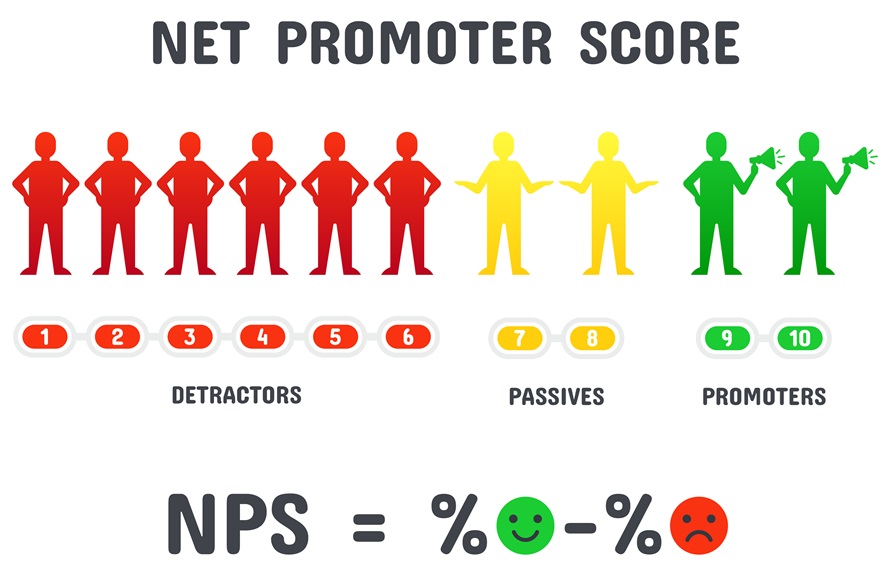Customer experience metrics enable organizations to track their customers’ interactions with the brand and understand how they feel about their products and services in order to provide better experiences.
Customers are key to making your business successful. Giving them what they expect or want not only enhances their satisfaction levels but also improves your sales.
And to know if they are happy with your products and services, it is necessary to measure
customer experience management metrics.
Let’s discuss what these metrics are and understand how measuring them will benefit your business.
What Is Customer Experience Metrics?
Customer experience metrics are the parameters used to measure the customer experience and happiness with your products, services, and brand. There are many customer experience metrics, such as customer satisfaction scores, retention rates, churn rates, social media sentiment, and so on, that you can consider tracking based on your needs.
An organization measures these metrics to understand what its target customers actually feel about its offering. This is a powerful insight, which helps them work towards weak areas and improve their products and services. As a result, they can attract more customers while reducing the gap between customers and the organization.
While choosing the metrics to track, you must decide which gaps need to be filled first and explore the touchpoints to know customers’ satisfaction levels and trust. On the other hand, you can use your selected metrics as the Key Performance Indicators (KPIs) to give a boost to your team’s performance and let them improve the overall satisfaction levels.
Benefits of Customer Experience In Business Success
Let’s discuss some of the benefits of managing customer experiences in your business:
Lifetime Customer Retention
When you work on providing a good experience to your customers with your products or services, your customers will take a greater interest in the offerings and trust your brand. This means your customers will engage with your brand as you fulfill their demands and expectations.
Increasing customer satisfaction allows you to retain them for a longer period, which brings more profits.
Build a Great Reputation

Making your customers happy is a crucial part of your marketing campaigns. When your customers engage with your brand, they share their happiness with others. This enables other customers to engage with your brand, building a great reputation in the market.
Increase Sales and Drive Revenue
By fulfilling your customers’ expectations, you ensure a great customer experience. And when customers are happy with your brand, they continue using your products and services. This increases your sales and revenue.
Other benefits are:
- Beat competition: You are not the only one in the market; there are numerous competitors. To stand out among them, you must attract your customers by providing quality services and fulfilling their wishes. This way, you can grow even more, beating the competition.
- Loyalty: If you build your business around strong initiatives and unique strategies focusing on better customer experiences, it will foster trust and loyalty towards your products and services. This will help you build a great company and lead to business success.
Importance of Measuring Customer Experience Metrics
Customer experience metrics help you optimize your efforts and strategies so that you can better attract them to your brand and drive success. Therefore, it is essential to consider customer experience measurement metrics.
When you appropriately use metrics to measure customer experience and act immediately upon them, you can improve your products or services in no time, letting your customers stay with your brand. However, it is not an easy job to measure customer experiences if you do not have the right data, survey reports, feedback, etc.
Therefore, you need to collect data from your customers based on what they like the most in your product, what they want you to improve, any features they want you to add to the product or service, etc.
This data helps you measure customers’ satisfaction levels and improve your products and services wherever necessary to drive the growth of your company.
So, measuring customer experiences lets you define your priorities, attract more customers, give trust to your customers, increase sales, engage employees to build strategies, and bring more benefits.
Customer Experience Metrics to Measure
Net Promoter Score (NPS)
Net Promoter Score (NPS) is a primary metric for measuring customer experience by tracking their loyalty towards your products and services. It helps you calculate the percentage of users who do not like your brand, users who love your brand, and users who are neutral in their opinions. 
In addition, it is easy to calculate and form metrics that you can utilize to send a survey to your customers, including questions, multiple choice questions, ratings, etc. NPS helps organizations enhance their customer support, add more features, improve delivery, etc., to attract more customers.
In order to measure customer loyalty, you can send a survey that includes various questions about the product, service, support, etc. This helps you understand how a customer accepts your brand and if they wish to recommend a product/service to others.
On a scale of 0-10, your customers choose their numbers so that you can know how many are happy and how many aren’t.
Customer Satisfaction Score (CSAT)
Customer satisfaction score is a straightforward way of measuring customer satisfaction in using your products and services. It tells you how many customers are happy with your brand. You can utilize key performance indicators to measure satisfaction scores or send a survey to your customers to get data on their ratings from 0-10, 0-5, or 0-3.
Instead of quantitative data, you can also go with qualitative data by using some verbal indicators like very happy, happy, neutral, not happy, not to recommend, etc. Furthermore, you can use symbols like stars, smiley faces, thumbs, and so on to collect data.
Here’s what the CSAT formula looks like:
CSAT = 100 x (sum of responses, i.e., positive or negative/total responses)
For example, if you get a total of 100 responses, out of which 75 are positive responses, 20 are negative responses, and 5 are neutral, your CSAT score will be 75% (positive responses).
Customer Effort Score (CES)
Customer Effort Score is one of the key customer experience metrics used by organizations to measure the effort that customers put into purchasing your product, returning or exchanging the product, getting solutions to problems, receiving answers to concerns, and more.
This is basically the measurement of customers’ interactions with your company.
Customers trust those companies that strive to make customer journeys smoother. Customer Effort Score lets you track customers’ satisfaction by eliminating long queues in service calls, spending more time exploring products or services, and more. You can measure customer scores directly after any interactions like purchase or return of products, communicate with service teams, etc.
To calculate the score, you can let them freely share their feedback, share follow-up questions, and ask them to give reviews. The formula is
Customer Effort Score = Total sum of customers’ ratings / total number of responses
With this score, you can evaluate the latest customer behavior while using your products or services. Like other metrics, you can also collect data from your customers by letting them rate your service or customer support on a scale of 1-10.
Customer Churn Rate
Customer churn rate is the measurement of customers who cancel their subscriptions or don’t continue with any subscription plans in a given period (month or year). It is an essential metric for SaaS-based businesses that let their customers take subscriptions on a recurring basis. 
To calculate the percentage of customer churn, you can apply the below formula:
Customer churn rate = (number of customers who stop taking subscriptions in a given time period / Total customers at the beginning of that time period) x 100.
For example, if you have 100 customers at the start of December, from which you lost 10 customers at the end of December, the churn rate will be 10%.
To calculate the exact churn rate, you need to first determine a period (monthly, quarterly, or annually). Then, you can count the number of customers who take subscriptions during this period.
Therefore, the customer churn rate depends on the period of time you choose. This helps you improve your products and customer service experts, change onboarding plans for upcoming customers, train your sales reps, and more.
Average Handling Time (AHT)
Average handling time is the measurement of time that your support team needs to resolve your customers’ requests. This includes all the time that customers spend, including waiting time, hold time, follow-up time, and other time needed to fulfill customer expectations. So, this is the calculation of the average amount of time. 
Call centers generally use the AHT metric to know the average duration of calls. Moreover, businesses use this measurement process to analyze the waiting time for chats or emails. This enables you to determine how effectively your service team works to fulfill customer requests.
Time is the most valued thing for every customer. They want to spend less time interacting with the support team and expect to get the solutions quicker. By calculating the average time, you can track your service team’s performance and train people to give better support to your customers.
Customer Lifetime Value (CLV)
Customer lifetime value is one of the useful metrics that an organization uses to measure the total revenue it expects to generate from a given customer throughout its journey.
In this calculation, you can include purchases from the beginning and the duration of the customer journey. 
CLV helps you understand whether the customer is actively buying from your brand or not. If a customer purchases from you, again and again, it means you are providing a good experience to your customers.
To calculate an average value, you need to track customers’ historic lifetime value along with predictive lifetime value. Both are equally responsible for your business to track success. In predictive lifetime value, you need to calculate the average amount a customer could spend in the next few years by checking historic stats. The formula to measure CLV is:
CLV = Customer giving value to your business x average lifetime of a customer in your business relationship
First Response Time (FRT)
First response time is the measurement of duration from when a customer calls the support team to raise a ticket to when a member responds to the ticket. It includes minutes, days, or hours.
Many businesses include FRT data in their SLAs to attract customers. A good FRT is a sign of a good response rate provided to your customers. 
Checking FRT helps you resolve issues in the response workflow and provide faster responses to customers in less time, showing them you are always available to help whenever they face issues with your products and services.
To calculate the average FRT, here is the formula:
Average FRT= Total number of FRT / Total number of open tickets
If you take less time to resolve issues of customers, you are likely to provide a higher level of customer experience, letting them stay with your brand.
Customer Retention Rate
Customer retention rate measures a company’s ability to maintain good relationships with its customers for a longer time. It is the percentage calculation of the number of customers that stay with you over time (like a year, 5 years, etc.). To retain customers, you need to calculate customer retention rates. This will help you improve your processes and customer experiences.
Social media sentiment is an analysis of mentions of your brand in social media to get valuable insights into your customers’ feelings and opinions. 
In this calculation, you need to get information on how your customers feel and share their opinion on your products and services on social media platforms like Instagram, YouTube, Facebook, etc.
Social media sentiment analysis is a way of searching for context or words in social media platforms to understand your brand quality. This helps you improve your services, train your team, optimize production, provide add-ons to your product or service, and do more.
How to Collect and Analyze Customer Feedback
Customer feedback is essential for businesses if you want to understand customers’ experience and improve your offerings.
There are many ways through which you can collect customers’ feedback – surveys, emails, forms, etc. Allow customers to rate your product or service based on their experiences.
Furthermore, you can collect feedback from social media reviews, interviews, testing, and so on.
From the data and insights you’ve collected, you can categorize them and associate them to features, user experiences, etc., to understand how your product and services are helping your customers along with the difficulties they face.
You can leverage some customer experience management software to analyze the data and process it to improve your strategies and decision-making.
Significance of Personalization in CX

When you understand your customers’ expectations and difficulties and provide solutions that can address their unique needs, you are essentially personalizing your offerings.
It is a necessary approach to providing a better customer experience and retaining them for a longer time.
To do so, you can build and manage customer profiles and segment these profiles into different groups based on locations, preferences, ages, genders, etc. Also, you can create personalized emails or messages for the segmented customers and offer them personalized promotions, coupons, discounts, etc.
Therefore, personalization helps you provide a great customer experience and enhances your sales.
Strategies for Customizing Experiences to Individual Customer Preferences

Let’s discuss the strategies you can follow to provide personalized experiences to your customers.
- Track your customers’ behavior and online activities by checking historical data.
- Collect data from feedback, social posts, reviews, surveys, etc., to understand your brand’s position in the market.
- Understand your customers’ expectations from the data
- Segment your customers according to their expectations of your brand.
- Create customized marketing campaigns for your customers by providing coupons, discounts, add-ons, etc.
- Send marketing emails based on locations, genders, preferences, etc.
- Keep emails or messages short and attractive.
As a result, customers will be encouraged and show more interest in your brand, increasing your productivity and sales.
FAQs
Answer: Customer experience metric is a parameter that you can calculate to understand customer’s experience with your offerings from their reviews, ratings, emotions, feelings, etc.
Answer: When you calculate customer experience metrics and find that your customers are happy with your offerings, then your strategy is good. But if they aren’t happy, then you must improve your strategy.
Answer: The KPIs or metrics to measure customer experience are customer satisfaction score, customer effort score, customer churn rate, average handling time, customer lifetime value, customer retention rate, social media sentiment, first response time, and more.
Conclusion
Measuring customer experience metrics helps you understand your customer’s experience with your brand and improve your strategies to drive success.
I have discussed some of the customer experience metrics examples that can help you gather data on team performance, product value, customers’ interests, etc.

